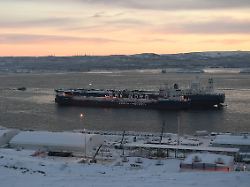Prices over $60 a barrel
Study: Price cap for Russian oil failed
02/28/2023, 7:42 p.m
At the beginning of December, the West capped the price of Russian oil at $60 per barrel. Nevertheless, Russian companies earn significantly more on average, a study shows. The plan to dry up the Kremlin’s source of funds in this way is not working. Experts recommend turning the price screw.
The Western allies’ plan to cap the Kremlin’s oil revenues with a price cap is having no effect. Instead of $60 a barrel, the price of Russian crude oil has averaged about $74 in the four weeks since the price cap was introduced, according to a joint study by Columbia University, the University of California and the Institute of International Finance.
On December 5, the EU, the G7 countries and Australia imposed an oil embargo and a price cap on Russian oil. Goal: The combination of an import ban and a price cap should “significantly reduce” Russia’s revenues, while at the same time the mixture should stabilize global prices. The source of money that finances the war in Ukraine should thus be dried up.
Unlike in the EU, where imports are banned entirely, in other countries where it is not possible to do without Russian oil entirely, a price cap of a maximum of $60 per barrel applies. Companies and traders can only use a large number of Western services for Russian oil exports – in particular the insurance policies customary in the industry – if they really did not pay more for the oil. Only if this is the case, the oil transport is also allowed.
As the study shows, Russia still manages to sell oil at significantly higher prices. The “surprising finding that a significant portion of Russian crude oil was sold well above the $60 per barrel price ceiling urgently warrants further investigation into these transactions and underscores the need for tougher action,” the researchers say. The study based on data on crude oil sales at customs offices around the world.
They cite several reasons why the Kremlin’s oil revenues have not fallen more sharply than expected. For one, Russia has been able to divert crude oil exports from Europe to alternative markets such as India, China and Turkey – in roughly the same volume. Even though Russia has given these customers big discounts, it hasn’t made a big dent in exporters’ coffers, as oil and gas prices have been at record levels in the previous months.
On the other hand, Russia benefits from significant price differences on the oil market, depending on where the oil is exported from Russia. According to the study, what used to be the most important Russian crude oil, the Urals, is sold from the hubs in the Baltic and Black Seas for well under $60. At the same time, however, Russia’s oil exports from the ports in the Pacific Ocean to countries like China achieve prices averaging $82 per barrel – that is $22 more than the specified price cap per barrel.
Russia-friendly oil tankers avoid sanctions
In addition, Moscow benefits from a huge shadow fleet of old, decommissioned oil tankers that transport and sell Russian oil without the participation of Western companies. The vessels are owned by offshore companies that are difficult to trace. How many there are exactly is not known. Commodity giant Trafigura estimates there could be 600 in total. But their number could well be higher. These – like the freighters of the state-controlled shipping company Sovcomflot – unlike the western shipping companies, do not comply with the sanctions requirements.
According to the study, a total of 50 percent of Russian oil is transported by tankers that circumvent the sanctions. Conversely, this means that only half of Russian oil exports will feel the price restrictions – if the transport is handled by Western shipping companies. The EU embargo and the price cap on Russian oil have divided the market, which is helping Russia, the researchers note.
According to the authors of the study, the focus of future Russia policy must be the enforcement of existing sanctions. The EU embargo on Russian refinery products such as diesel and kerosene, which also came into force at the beginning of this month, is being positively highlighted as an additional instrument to curb Russian export and tax revenues.
In order to give the measures more emphasis and to demonstrate toughness against Russia, the study recommends an even more drastic measure: the authors support the initiative of the “International Working Group on Russian Sanctions”, a kind of task force for the implementation of the measures against Russia, in their Demand to cap Russian crude oil prices at $35. They recommend a similar “aggressive” approach to oil products such as diesel and kerosene.
